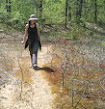I know next to nothing useful about agriculture, so I can usually resist writing about it.
But I recently saw someone cut and regrade their yard's globally endangered forest so they could put in what only amounted to a few square meters of hobby veggie garden beds. It's nothing new but it made me think, wow... there have got to be better agricultural models that would have included that forest.
Also in the last 3 years I've seen urban agriculture and native plant naturalization sharing tight spaces here in Toronto, and ask each other what's possible.
I've read about prairie ecosystem models for sustainable agriculture from the US midwest. Good stuff, especially for existing field crop areas where the forests are already gone.
But, lately my mind keeps heading toward a woodland->forest agricultural concept.
I started imagining, composing and recomposing them and their species in my mind (I was trying to stick entirely to native for the longest time, but now I'm ready to accept some integration) for our region.
It's not exactly urban agriculture or any orchards as I've known them, and it's certainly not wild-crafting, or foraging, or nomadic seasonal wild gathering. It's a deliberate integration of naturalization and conservation + sustainable human agriculture, vertically layered, that could work on smaller landscapes (e.g. 1 acre) and larger areas too. Trying to suss it out, I found out I liked Norfolk Alternative Land Use Services, and then bingo: I stumble across a diagram that looked a lot like the same of the idea I had in my mind: Apparently it's called "Forest Gardening". Check it out.
Apparently it's called "Forest Gardening". Check it out.
First thing I did was laugh! :) because just looking at that diagram with its different forest vegetation layers, you can see how easily anyone with a native plant / field naturalist bent raised in "mixedwood plains" would come up with this as a potential agriculture model. Made me realize how impossible it is for me to even imagine how anyone ever developed our current conventional agricultural models.
I can see it working in some back yard gardens, or even a research site, as a forest restoration + agriculture joint project. But I'd be hesitant to advocate it for some public org's sites because I simply don't know how it road-tests with food security and hunger: I have no idea how much nutrition and energy/calories it provides and requires per acre compared to common organic agriculture alternatives like an average small plot heirloom annual veggie garden, or prairie ecosystem agriculture models. The other thing that confounds me are our suitable nut species, e.g. chestnut blight and butternut fungus thins the ranks.
At the very least it's something worth considering when folks are deciding how to share limited land desired, or needed, for food and forest.
22 May 2009
Forest Gardening
Subscribe to:
Post Comments (Atom)


No comments:
Post a Comment